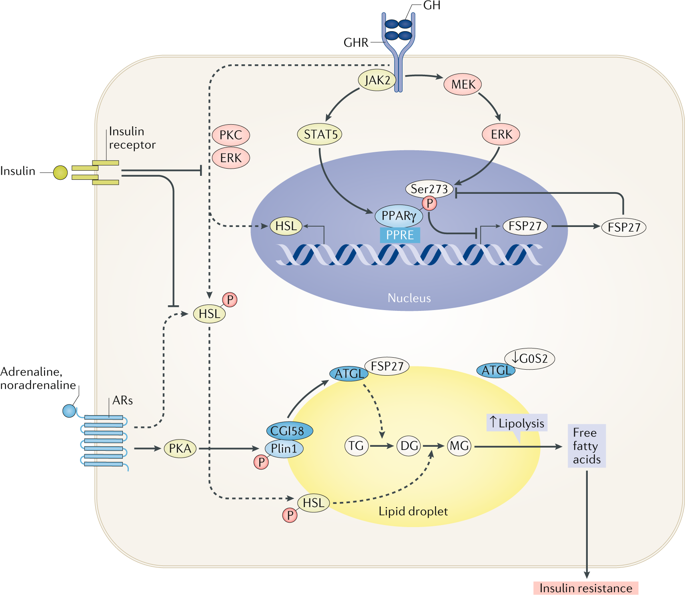当前位置:
X-MOL 学术
›
Nat. Rev. Endocrinol.
›
论文详情
Our official English website, www.x-mol.net, welcomes your
feedback! (Note: you will need to create a separate account there.)
The effects of growth hormone on adipose tissue: old observations, new mechanisms.
Nature Reviews Endocrinology ( IF 31.0 ) Pub Date : 2019-11-28 , DOI: 10.1038/s41574-019-0280-9 John J Kopchick 1, 2, 3 , Darlene E Berryman 1, 2, 3 , Vishwajeet Puri 2, 3 , Kevin Y Lee 2, 3 , Jens O L Jorgensen 4
Nature Reviews Endocrinology ( IF 31.0 ) Pub Date : 2019-11-28 , DOI: 10.1038/s41574-019-0280-9 John J Kopchick 1, 2, 3 , Darlene E Berryman 1, 2, 3 , Vishwajeet Puri 2, 3 , Kevin Y Lee 2, 3 , Jens O L Jorgensen 4
Affiliation

|
The ability of growth hormone (GH) to induce adipose tissue lipolysis has been known for over five decades; however, the molecular mechanisms that mediate this effect and the ability of GH to inhibit insulin-stimulated glucose uptake have scarcely been documented. In this same time frame, our understanding of adipose tissue has evolved to reveal a complex structure with distinct types of adipocyte, depot-specific differences, a biologically significant extracellular matrix and important endocrine properties mediated by adipokines. All these aforementioned features, in turn, can influence lipolysis. In this Review, we provide a historical and current overview of the lipolytic effect of GH in humans, mice and cultured cells. More globally, we explain lipolysis in terms of GH-induced intracellular signalling and its effect on obesity, insulin resistance and lipotoxicity. In this regard, findings that define molecular mechanisms by which GH induces lipolysis are described. Finally, data are presented for the differential effect of GH on specific adipose tissue depots and on distinct classes of metabolically active adipocytes. Together, these cellular, animal and human studies reveal novel cellular phenotypes and molecular pathways regulating the metabolic effects of GH on adipose tissue.
中文翻译:

生长激素对脂肪组织的影响:旧发现,新机制。
已知生长激素(GH)诱导脂肪组织脂解的能力已有50多年的历史。然而,几乎没有文献报道介导这种作用的分子机制和GH抑制胰岛素刺激的葡萄糖摄取的能力。在同一时间范围内,我们对脂肪组织的了解已发展为揭示具有不同类型的脂肪细胞,贮库特异性差异,生物学上重要的细胞外基质和由脂肪因子介导的重要内分泌特性的复杂结构。所有这些前述特征继而可以影响脂肪分解。在本综述中,我们提供了GH在人类,小鼠和培养细胞中的脂解作用的历史和当前概述。在全球范围内,我们根据GH诱导的细胞内信号传导及其对肥胖的影响来解释脂解作用,胰岛素抵抗和脂毒性。在这方面,描述了限定GH诱导脂解的分子机制的发现。最后,提供了关于GH对特定脂肪组织贮库和不同类别的代谢活性脂肪细胞的不同作用的数据。这些细胞,动物和人类研究共同揭示了调节GH对脂肪组织代谢作用的新型细胞表型和分子途径。
更新日期:2019-11-29
中文翻译:

生长激素对脂肪组织的影响:旧发现,新机制。
已知生长激素(GH)诱导脂肪组织脂解的能力已有50多年的历史。然而,几乎没有文献报道介导这种作用的分子机制和GH抑制胰岛素刺激的葡萄糖摄取的能力。在同一时间范围内,我们对脂肪组织的了解已发展为揭示具有不同类型的脂肪细胞,贮库特异性差异,生物学上重要的细胞外基质和由脂肪因子介导的重要内分泌特性的复杂结构。所有这些前述特征继而可以影响脂肪分解。在本综述中,我们提供了GH在人类,小鼠和培养细胞中的脂解作用的历史和当前概述。在全球范围内,我们根据GH诱导的细胞内信号传导及其对肥胖的影响来解释脂解作用,胰岛素抵抗和脂毒性。在这方面,描述了限定GH诱导脂解的分子机制的发现。最后,提供了关于GH对特定脂肪组织贮库和不同类别的代谢活性脂肪细胞的不同作用的数据。这些细胞,动物和人类研究共同揭示了调节GH对脂肪组织代谢作用的新型细胞表型和分子途径。





















































 京公网安备 11010802027423号
京公网安备 11010802027423号